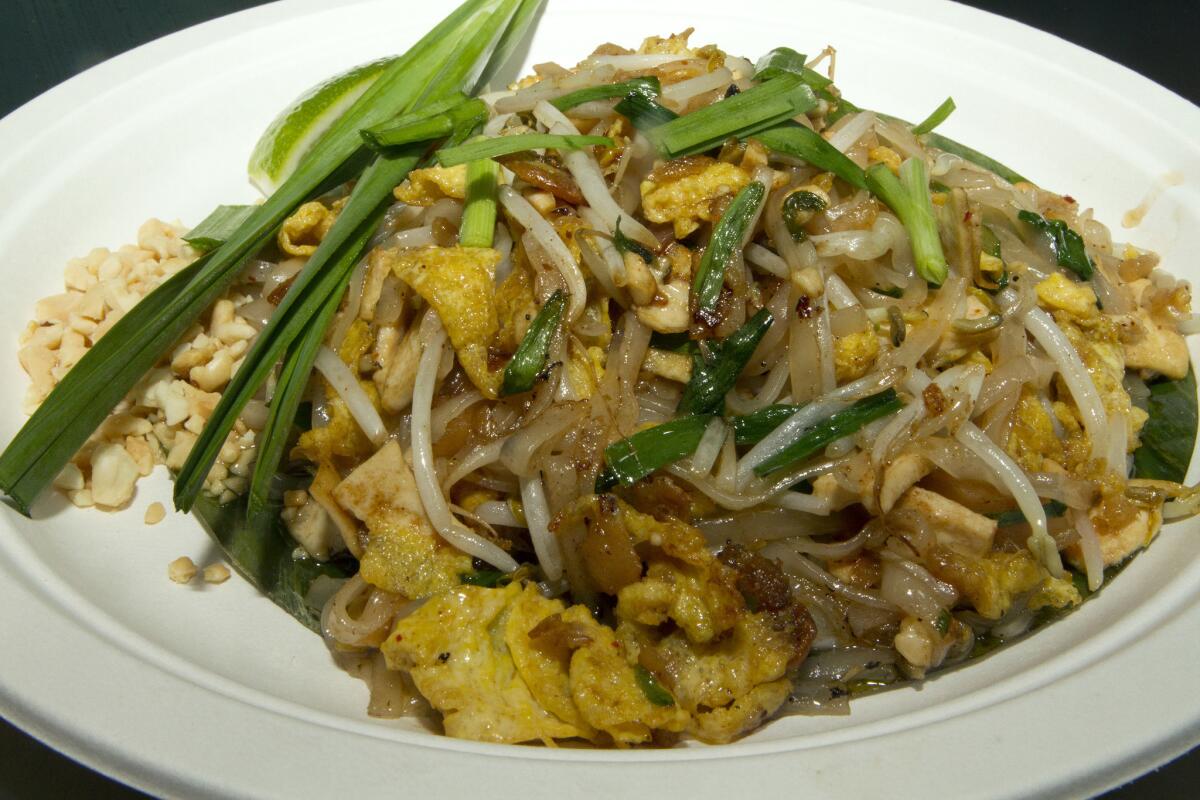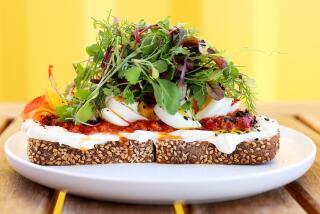Restaurant review: Pok Pok Phat Thai in Chinatown, a learning process

Pok Pok Phat Thai is the first Los Angeles outpost of Andy Ricker, the American-born chef who has built a small Thai food empire in Portland, Ore., and New York. It is a small counter built into the Chinatown mall storefront where the chicken pho dive Hoan Kiem used to be, right down from Chego, and even in its earliest weeks a line curled out its door. Ricker is adept at adapting the strong, herbal flavors of northern Thai drinking food — his original Pok Pok in Portland is marvelous — in a manner fairly similar to what Kris Yenbamroong is doing here at Night + Market.
He plans to open a larger, more ambitious restaurant up the street in a few months, but Pok Pok Phat Thai serves just noodles for takeout or to eat at one of the oilcloth-covered picnic tables set outside in the mall. There is an assortment of Ricker’s drinking vinegars, splashed with soda (I like the one made with pungent Chinese celery), and Thai iced coffee made with cold-brewed Stumptown. The vegetable dish on the specials board has never been available, to my knowledge — the counterman says that the right basil has never been available — but you can get water spinach stir-fried with garlic and fermented yellow beans if the noodles alone aren’t enough.
The restaurant’s specialty, the one Thai dish your Aunt Josephine is likely to have opinions about, is rarely fetishized by gourmets. Most local versions are characterized by sugary sweetness, stiff rice noodles and fistfuls of chopped peanuts and bean sprouts. Thai people tend to tighten their smiles when you bring up the dish — the question of what a great plate of phat Thai might entail is probably about as interesting as the aesthetics of a tuna salad sandwich might be to an average American.
When you snag a table at Pok Pok Phat Thai, you will find a condiment caddy holding jars of white sugar, ground dried chile, tiny bird peppers in fish sauce and sliced chiles in vinegar. You’ve probably seen the same jars in every Thai restaurant you’ve ever visited, and apart from the odd spoonful of chile you’ve plopped into a bowl of duck noodle soup, you’ve probably ignored them.
But when your phat Thai finally comes — food is prepared at what might be called an artisanal pace here — the noodles are soft and warm, larded with crunchy bits of fried pigskin and flavored with a splash of tamarind and the rendered pork fat in which it has been fried, but they are bland, intentionally so. The kitchen has done its work; it is time for you to do yours.
You could eat the noodles as is, perhaps stirring in the bean sprouts and ground peanuts strewn to one side, but you would find the dish one-dimensional, almost too tedious to finish. A spritz from a lime wedge puts life into the noodles, a bit of acidity; a sprinkle of toasty ground chile from the jar adds a mellow heat and some color, but the dish still doesn’t taste that much like phat Thai. If you drizzle pepper vinegar over the noodles, the flavor will be closer to what you’re going for, and if you bravely toss in a few drops of Thai fish sauce (Have you ever smelled that stuff?), the complex saltiness and the blast of umami bring the aroma closer still.
The flavor is still not quite there. While you know that you should probably add a little sugar — it says so right on the menu — you resist it for a minute because you know all about the evils of white sugar and because you have always believed that the main problem with mall Thai food is that it is always too sweet. But you add the sugar, and then some more dried chile. And the noodles explode into loveliness, like phat Thai only somehow better, perhaps because the noodles have been cooked correctly, sautéed over a low heat rather than blasted with maximum flame, and the subtle, flowery fragrance of tamarind starts to bloom.
The rudimentary phat Thai has become a wonderful plate of noodles, possibly even better than the spicy, tart version at Krua Thai in North Hollywood, which until now has been the standard-bearer in town. More important, you have begun to learn how to season, how to balance flavors within the context of Thai cuisine. The next time, your noodles will be better; the time after that, they will be better still. It’s a little like cooking through a recipe that instructs you to salt to taste. It will always taste better the third time around.
Somebody raised in Thailand may think that this rudimentary lesson is silly, as you might when you visit a burger bar in Tokyo and find customers marveling over ketchup, mustard and relish, but we’ll discuss that brand of cultural relativism later.
For an extra dollar or two, you can get your phat Thai with firm tiny shrimp, with crumbles of ground pork or both. (There is a vegetarian version too.) There are smoky, nicely wok-seared versions of the wide, soft rice noodle phat sii ew fried with egg, pork and Chinese broccoli, and slightly denser kuaytiaw noodles fried with cuttlefish and either chicken, shrimp or sliced duck. Ricker’s version of the Bangkok street food classic hoi thawt, crisp rice-flour crepes tossed with eggs, greens and tiny Prince Edward Island mussels, is delicious, especially with a splash of peppery Thai Sriracha sauce.
But the most interesting question about Pok Pok Phat Thai is less about what might be on the slim yellow menu than it is about your own philosophy of dining: What do you, as a presumably non-Thai enthusiast of Thai cooking, really want from a dish? How much comfort do you demand from your surroundings? And does a bag of peanuts fried with makrut lime leaves really qualify as an appetizer?
If you are in the mood for dessert afterward, the Chinatown branch of the avant-garde gelateria Scoops is just across the hall. While you’re there, you might as well pick up a pandan-leaf latte from Cognoscenti Coffee too.
jonathan.gold@latimes.com
Follow me on Twitter
@thejgoldMore to Read
Eat your way across L.A.
Get our weekly Tasting Notes newsletter for reviews, news and more.
You may occasionally receive promotional content from the Los Angeles Times.











